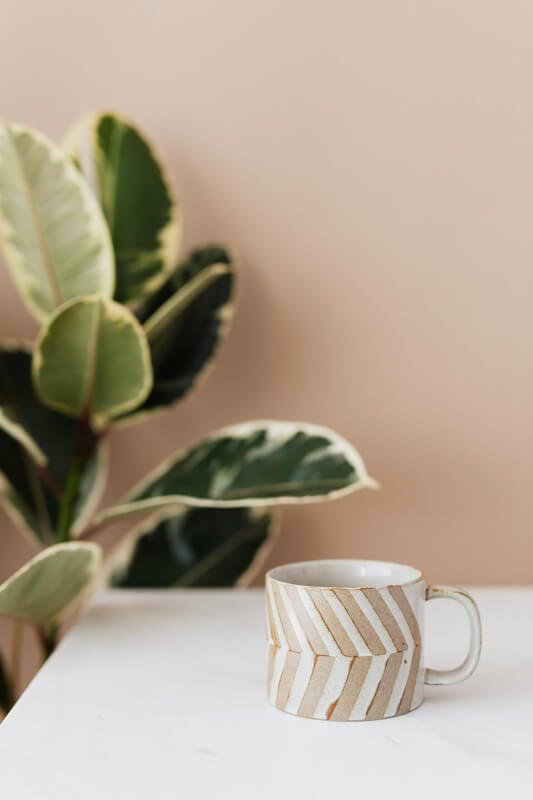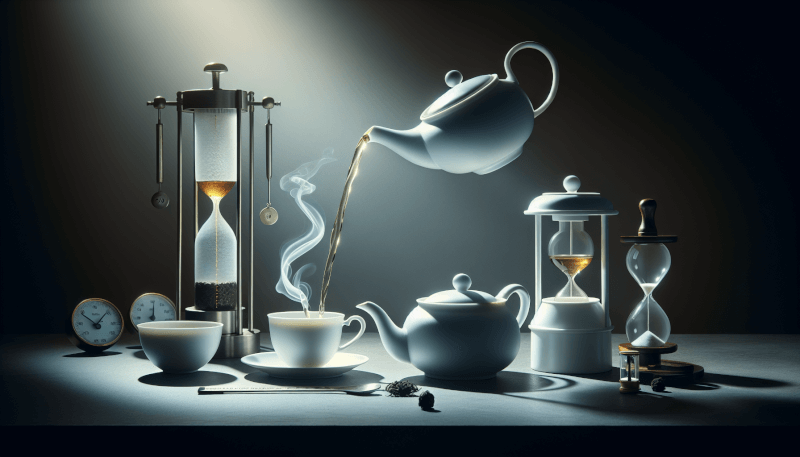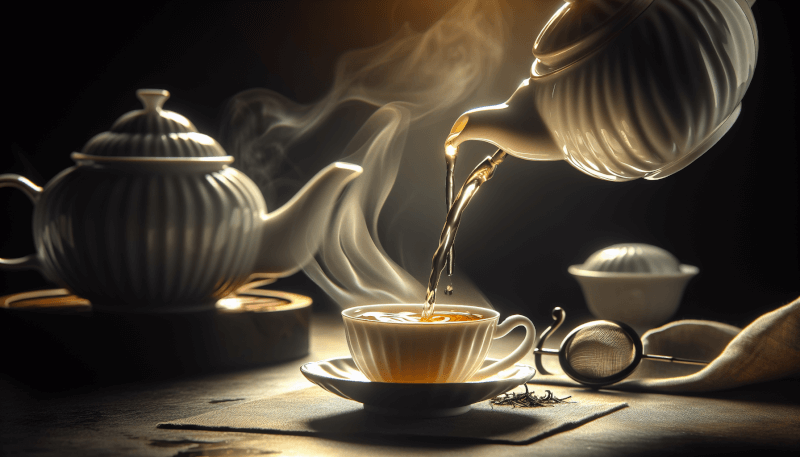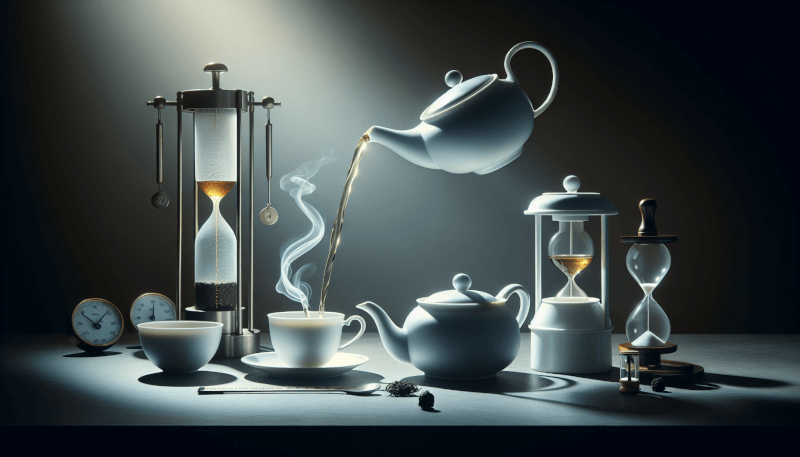Do you ever wonder how to make your cup of tea more flavorful and aromatic? Look no further! In this article, you will discover some tea brewing techniques that will take your tea experience to a whole new level. From adjusting the water temperature to steeping times, we will explore the various methods to enhance the flavor and aroma of your favorite teas. So grab your teapot and get ready to unlock the secrets to a truly delightful tea-drinking experience!
Choosing the Right Tea Leaves
When it comes to brewing the perfect cup of tea, choosing the right tea leaves is crucial. With so many different types of tea available, it can be overwhelming to know where to start. The key is to understand the different types of tea and their characteristics, so you can select the one that suits your taste preferences.
Understanding the Different Types of Tea
Tea can be categorized into several main types: black, green, oolong, white, and herbal. Each type has its own unique flavor profile and brewing requirements.
Black tea is fully oxidized and has a robust, malty flavor. It is usually the strongest in terms of caffeine content and pairs well with milk and sweeteners. Green tea is unoxidized and has a lighter, grassy taste. It is known for its numerous health benefits and delicate aroma. Oolong tea falls somewhere between black and green tea, with a partially oxidized leaf and a range of flavors from floral to fruity. White tea is the least processed and has a subtle, delicate taste. Finally, herbal teas are made from various herbs, fruits, and flowers, offering a wide range of flavors and caffeine-free options.
Selecting High-Quality Tea
To ensure a delicious cup of tea, it’s important to choose high-quality tea leaves. Look for teas that are fresh, whole-leaf, and sourced from reputable tea gardens or estates. Avoid tea bags that contain powdered or broken leaves, as they can result in a weaker flavor. Opt for loose-leaf teas, as they allow for better infusion and flavor extraction.
When selecting tea, consider the aroma, color, and texture of the leaves. The aroma should be fresh and fragrant, while the color should be vibrant and indicative of the tea type. The texture of the leaves should be intact, without any sign of damage or excessive crumbling.
Considering Varieties and Blends
In addition to the different types of tea, there are also numerous varieties and blends to choose from. Varieties refer to teas from specific regions that have unique characteristics and flavors. For example, Darjeeling tea from India is known for its muscatel flavor, while Matcha from Japan offers a vibrant green color and a rich umami taste.
Tea blends, on the other hand, are created by combining different types of teas or adding other ingredients such as herbs, flowers, or fruits. These blends can offer a wide range of flavors and aromas, allowing you to discover new taste combinations. Some popular blends include Earl Grey (black tea with bergamot), Jasmine green tea (green tea scented with jasmine flowers), and Chamomile lavender (herbal blend).
Experimenting with different varieties and blends is a great way to find your favorite tea and expand your tasting experience. Don’t be afraid to try something new and discover the diverse world of tea.
Water Temperature and Quality
While choosing the right tea leaves is important, the quality of water and its temperature also plays a significant role in brewing a flavorful cup of tea. Understanding the importance of water temperature and using filtered water can greatly enhance the taste and aroma of your tea.
The Importance of Water Temperature
Different types of tea require different water temperatures for optimal flavor extraction. Using the wrong water temperature can result in a bitter or weak brew. Hotter water can extract more tannins and bitter compounds from the tea leaves, while cooler water may not extract enough flavor.
Determining Optimal Temperature for Different Teas
As a general rule, black teas and herbal teas can be brewed with water that has been brought to a rolling boil (212°F or 100°C). Green teas and white teas, on the other hand, are more delicate and require lower temperatures to avoid a bitter taste. Ideally, green teas should be brewed with water around 160°F to 180°F (71°C to 82°C), while white teas can be brewed with water around 175°F (79°C).
Oolong teas fall in between, with a wide range of flavors that can be achieved by adjusting the water temperature. Experimentation is key when brewing oolong teas to find the temperature that best suits your taste preferences.
Using Filtered Water for Better Flavor
The quality of water used in tea brewing can greatly affect the taste and aroma. Tap water may contain impurities, such as chlorine or minerals, which can alter the flavor of the tea. Using filtered water can help remove these impurities and result in a cleaner, purer taste.
Investing in a water filter or using bottled water can be beneficial, especially if your tap water has a strong taste or odor. Filtered water will allow the true flavors of the tea to shine through, providing a more enjoyable tea-drinking experience.

Proper Tea-to-Water Ratio
Finding the right tea-to-water ratio is another important aspect of brewing a perfect cup of tea. The ratio determines the strength and flavor intensity of the final brew.
Importance of Measuring Correctly
Measuring the tea and water accurately ensures consistency in your brewing. Using too much tea can make the brew too strong and overpowering, while using too little tea can result in a weak and flavorless cup.
A good starting point is to use one teaspoon of loose-leaf tea per 8-ounce (240ml) cup of water. Adjust the amount based on personal preference and the intensity of the tea flavor you desire.
General Guidelines for Different Teas
Different teas may require slightly different ratios to achieve the best results. For example, black teas often taste best with 1 teaspoon of tea per cup, while green teas may only need ½ to ¾ teaspoon per cup. Again, these guidelines can be adjusted based on personal taste preferences.
Adjusting Ratio to Personal Taste
Everyone has their own preferences when it comes to the strength of their tea. Some people enjoy a strong, robust brew, while others prefer a milder flavor. Feel free to experiment with the tea-to-water ratio to find what works best for you.
If you find that your tea is consistently too strong or too weak, adjust the amount of tea or water accordingly. Keep in mind that certain teas, such as black teas, are more forgiving and can handle slightly stronger ratios, while delicate teas like green teas may require a lighter touch.
Steeping Time
The duration that tea is steeped, or soaked, in hot water also greatly impacts its flavor. Steeping time can vary depending on the type of tea and personal preference.
Recognizing and Avoiding Over-Steeping
Over-steeping can cause tea to become bitter and unpleasant. It is important to recognize the signs of over-steeping, such as a dark and cloudy brew, and adjust your steeping time accordingly.
To avoid over-steeping, follow the recommended steeping times for the specific type of tea you are brewing. Green and white teas generally require shorter steeping times, while black and herbal teas can handle longer brew times.
Timing Recommendations for Various Teas
As a general guide, black teas should be steeped for 3 to 5 minutes, while green teas typically require 1 to 3 minutes. White teas may only need 2 to 3 minutes, and herbal teas can range from 5 to 7 minutes. These times can be adjusted based on personal taste preferences.
Remember, these are only guidelines, and you can experiment with different steeping times to discover the flavor profile that suits you best. The beauty of tea brewing lies in the ability to adapt and tailor the process to your liking.
Experimenting with Steeping to Enhance Flavor
If you want to enhance the flavor of your tea, consider experimenting with longer or shorter steeping times. Increasing the steeping time can intensify the flavors, while reducing it can result in a lighter and more delicate brew.
Take note of the flavors and aromas that develop during different steeping times and adjust accordingly. Tea brewing is an art that allows for creativity and personalization, so don’t be afraid to explore and try new techniques.

Tea Infusers and Brewing Methods
Tea infusers play a crucial role in the tea brewing process. They hold the loose-leaf tea, allowing it to infuse the hot water and extract its flavors. There are various types of tea infusers available, each with its own benefits and drawbacks.
Exploring Different Tea Infusers
Tea infusers can range from simple stainless steel mesh balls to sophisticated glass teapots with built-in infusers. Other popular options include tea filters, teabags, and reusable tea sachets.
Mesh balls are a popular choice for their simplicity and ease of use. They can easily be filled with loose-leaf tea and submerged into hot water, allowing for a convenient brewing process. Tea filters, on the other hand, offer a larger capacity and are ideal for brewing larger quantities of tea.
Teabags, although convenient, often contain lower-quality tea and restrict the movement of the tea leaves, making it more challenging for them to release their full flavor. Reusable tea sachets provide a more eco-friendly option, allowing you to fill them with your preferred loose-leaf tea.
Benefits and Drawbacks of Each Infuser Type
Each type of tea infuser has its own benefits and drawbacks. Mesh balls and tea filters are easy to use and clean, but they may not allow for the full expansion and extraction of tea leaves. Teabags and reusable tea sachets are convenient but may limit the movement of the leaves, resulting in a less flavorful brew.
Glass teapots with built-in infusers offer a visually appealing brewing experience and allow the leaves to fully expand, producing a more flavorful cup of tea. However, they may be more delicate and require careful handling.
Consider your preferences, brewing style, and the type of tea you are brewing when selecting a tea infuser. It’s all about finding the method that suits you best and allows you to achieve the desired flavor and aroma.
Alternative Brewing Methods: Gongfu, Chai Walla, etc.
Beyond the traditional tea infusers, alternative brewing methods also exist that can take your tea experience to a whole new level. These methods, such as Gongfu style and Chai Walla, have their own unique techniques and rituals.
Gongfu style brewing originated in China and involves brewing tea in small teapots or gaiwans with a high leaf-to-water ratio. This method allows for multiple short infusions, resulting in a concentrated brew with rich flavors and aromas. Gongfu brewing is particularly suitable for oolong and pu-erh teas.
Chai Walla refers to the Indian style of brewing tea, which involves simmering tea leaves in water with spices and milk. This method creates a flavorful and aromatic spiced tea known as masala chai. It is a popular choice for those seeking a comforting and stimulating beverage.
Exploring these alternative brewing methods adds an element of excitement to your tea journey. Don’t be afraid to try new techniques and embrace different cultural practices to discover unique flavors and experiences.
Water Quality and Filtering
The quality of water used in tea brewing can significantly impact the taste and overall experience. Understanding the impact of water quality on tea and using filtered water can greatly enhance your tea-drinking experience.
Understanding the Impact of Water Quality on Tea Taste
Water quality plays a critical role in tea brewing because it affects the extraction of flavors and aromas from the tea leaves. Impurities in water, such as chlorine or minerals, can alter the taste and aroma of the brewed tea.
Water that is too hard (high in minerals) can result in a dry and astringent brew, while water that is too soft (low in minerals) can lead to a flat and weak taste. The ideal water for tea brewing should have a balanced mineral content and a neutral taste.
Filtering Water to Remove Impurities
Filtering the water used for tea brewing can help remove impurities and ensure a cleaner, purer taste. Water filters can effectively remove chlorine, sediment, and other impurities that may affect the flavor of the tea.
There are various types of water filters available, such as activated carbon filters, reverse osmosis filters, and ceramic filters. Choose a filter that suits your needs and budget, and follow the manufacturer’s instructions for proper installation and maintenance.
By filtering your water, you can experience the true flavors and aromas of the tea, allowing for a more enjoyable and authentic tea-drinking experience.
Using Different Water Sources: Tap, Bottled, Filtered
The choice of water source can also impact the taste of your brewed tea. Tap water is readily available and convenient, but it may contain impurities that can affect the flavor. If you have concerns about the quality of your tap water, using filtered or bottled water can be a good alternative.
Bottled water is generally filtered and purified, offering a reliable source of clean water for brewing tea. However, be sure to choose a still, low-mineral water that won’t overpower the delicate flavors of the tea.
Experiment with different water sources to see which one yields the best results for your preferred teas. Keep in mind that the quality and taste of the water will differ depending on your location, so it’s worth exploring different options to find what works best for you.

Pre-Heating Your Teapot or Cup
Pre-heating your teapot or cup is a simple yet important step in the tea brewing process. This step helps maintain the optimal temperature and prevent sudden temperature changes that can affect the flavor and aroma of the brew.
Why Pre-Heating is Important
Pre-heating your teapot or cup helps keep the water temperature consistent during brewing. If the teapot or cup is cold, it can cause the water temperature to drop rapidly when it comes into contact with the cold surface. This can result in under-extraction and a weaker brew.
Pre-heating also helps maintain the desired temperature throughout the steeping process, ensuring that the tea leaves release their full flavors and aromas.
Methods for Pre-Heating
There are several methods for pre-heating your teapot or cup. One common method is to pour hot water into the vessel and let it sit for a few minutes to warm up. Another method is to rinse the vessel with hot water before adding the tea leaves.
Be sure to discard the water used for pre-heating before adding the tea, as it may be cooler than the desired brewing temperature. Pre-heating should be done immediately before brewing to ensure the teapot or cup stays warm throughout the process.
Preventing Sudden Temperature Changes
Sudden temperature changes can be detrimental to the flavor and aroma of the tea. By pre-heating your teapot or cup, you minimize the likelihood of rapid temperature fluctuations that can negatively impact the final brew.
To maintain the optimal temperature, avoid placing the pre-heated vessel on a cold surface or exposing it to cold drafts. Keep the vessel insulated by placing it on a trivet or using a tea cozy. These precautions will help preserve the temperature and ensure a consistent and flavorful cup of tea.
Using Freshly Boiled Water
Boiling water is a crucial step in tea brewing as it provides the heat necessary to extract the flavors and aromas from the tea leaves. However, different types of tea have specific requirements when it comes to water temperature, making it important to understand the role of boiling water in the brewing process.
The Role of Boiling Water in Tea Brewing
Boiling water is the initial step in the tea brewing process as it activates the compounds in the tea leaves and allows for flavor extraction. The high temperature of the water helps break down the cell structure of the leaves, releasing their flavors, oils, and compounds.
While boiling water is suitable for many types of tea, it is not ideal for all. Certain delicate teas, such as green and white teas, can be adversely affected by boiling water, resulting in a bitter taste. Therefore, it is important to consider the specific requirements of the tea you are brewing.
Precautions to Avoid Boiling for Green and White Teas
To avoid boiling water for green and white teas, it is recommended to let the boiled water cool down slightly before pouring it over the tea leaves. Aim for a water temperature of around 160°F to 180°F (71°C to 82°C) for green teas and 175°F (79°C) for white teas.
To achieve the desired temperature, you can either let the boiled water sit for a few minutes or transfer it to a separate vessel to cool down. Investing in a temperature-controlled electric kettle or using a kitchen thermometer can also help you achieve the perfect water temperature for these delicate teas.
Maintaining the Optimal Temperature for Infusion
Regardless of the type of tea you are brewing, it is important to maintain the optimal water temperature throughout the steeping process. For teas that require boiling water, use a vessel with good heat retention properties, such as a ceramic teapot or a double-walled glass teacup. This will help keep the water temperature stable and avoid rapid cooling.
For delicate teas that require lower water temperatures, consider using a tea kettle with a built-in temperature control feature. These kettles allow you to set the desired temperature and maintain it throughout the steeping process, ensuring a consistent and flavorful brew.
By using freshly boiled water and paying attention to the specific water temperature requirements for each tea, you can enhance the flavors and aromas of your brew, resulting in a more enjoyable tea-drinking experience.

Finding the Right Steeping Time
The steeping time, or the duration that tea is soaked in hot water, is a critical factor in tea brewing. Steeping time greatly influences the flavor, strength, and overall character of the tea. It is important to understand the factors that influence steeping time and how to find the right duration for your personal taste.
Factors Influencing Steeping Time
Several factors can influence the steeping time of tea, including the type of tea, the desired strength of the brew, and personal preferences. Some teas, such as black and herbal teas, can handle longer steeping times without becoming overly bitter. Delicate teas, such as green and white teas, require shorter steeping times to avoid a bitter taste.
The desired strength of the tea also plays a role in determining the steeping time. If you prefer a milder brew, you may opt for a shorter steeping time, whereas a longer steeping time will result in a stronger and more robust flavor.
Finally, personal taste preferences should guide your choice of steeping time. Some people enjoy bold and full-bodied teas, while others prefer a lighter and more delicate cup. Don’t be afraid to experiment with different steeping times to find the perfect balance for your palate.
Taste Testing and Monitoring the Steep
To determine the right steeping time, it’s important to taste test the tea at regular intervals. Start by tasting the tea after the recommended steeping time for that particular tea. If it meets your desired flavor profile, you can strain the tea and enjoy. However, if the tea is too weak or strong, you can continue steeping for additional time.
Keep in mind that steeping times can vary depending on personal preferences and the specific tea you are brewing. It’s a good idea to note down the steeping times and adjust them accordingly for future reference.
Adapting Steeping Time to Personal Preference
Steeping time is highly subjective and can be adjusted to suit your personal taste. If you prefer a stronger brew, increase the steeping time by a minute or two. On the other hand, if you prefer a milder brew, decrease the steeping time slightly.
It’s all about finding the sweet spot that aligns with your taste preferences. With a bit of experimentation and careful observation, you can dial in the perfect steeping time to achieve a cup of tea that is precisely to your liking.
Experimenting with Tea Blends and Additions
Tea blends and additions offer an exciting opportunity to create unique flavor profiles and elevate your tea experience. By combining different types of tea and adding complementary ingredients, you can unlock a world of enticing flavors and aromas.
Creating Unique Flavor Profiles
Tea blends allow you to create unique flavor profiles by combining different types of tea. For example, you can blend black tea with green tea to achieve a balanced and robust cup. Alternatively, you can experiment with herbal tea blends by combining various herbs and flowers to create a customized infusion.
By exploring different tea blends, you can discover unexpected taste combinations and create teas that perfectly match your preferences.
Blending Different Teas and Complementary Ingredients
Complementary ingredients can also be added to tea to enhance its flavor and aroma. For example, adding a slice of lemon or a sprig of mint to black tea can offer a refreshing twist. Similarly, adding a bit of honey or a dash of cinnamon to herbal tea can bring out its natural sweetness and spiciness.
When blending different teas or adding complementary ingredients, remember to consider the flavors and characteristics of each component. Aim for a harmonious balance where the flavors complement and enhance each other.
Experimenting with different tea blends and additions is an opportunity to get creative and discover your own signature tea creations. Whether you prefer a classic combination or an unconventional twist, there are endless possibilities for crafting teas that are truly one-of-a-kind.
In conclusion, brewing the perfect cup of tea is an art that requires attention to detail and a willingness to experiment. By choosing the right tea leaves, understanding water temperature and quality, mastering tea-to-water ratio and steeping time, selecting the right tea infuser and brewing method, and considering the impact of water quality and pre-heating, you can enhance the flavor and aroma of your tea. Remember to embrace your personal taste preferences and have fun exploring different tea blends and additions. With practice and a sense of adventure, you’ll be able to brew a cup of tea that is perfectly suited to your preferences and enjoy all the delightful nuances that tea has to offer. So go ahead, put the kettle on, and embark on your tea-brewing journey with confidence!



